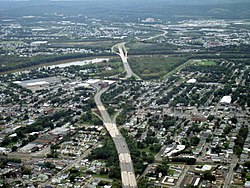Luzerne, Pennsylvania
Luzerne, Pennsylvania | |
|---|---|
Borough | |
 A picture of PA 309 as it travels through Luzerne and the surrounding communities. Luzerne is pictured in the foreground. | |
 Location of Luzerne in Luzerne County, Pennsylvania | |
| Coordinates: 41°17′02″N 75°53′34″W / 41.28389°N 75.89278°W | |
| Country | United States |
| State | Pennsylvania |
| County | Luzerne |
| Settled | 1807 |
| Incorporated | 1882 |
| Government | |
| • Type | Borough Council |
| Area | |
| • Total | 0.71 sq mi (1.83 km2) |
| • Land | 0.71 sq mi (1.83 km2) |
| • Water | 0.00 sq mi (0.00 km2) |
| Population | |
| • Total | 2,711 |
| • Density | 3,834.51/sq mi (1,480.62/km2) |
| Time zone | UTC-5 (Eastern (EST)) |
| • Summer (DST) | UTC-4 (EDT) |
| Zip code | 18709 |
| Area code | 570 |
| FIPS code | 42-45568 |
| Website | luzerneborough |
Luzerne is a borough located 5 miles (8 km) north of Wilkes Barre in Luzerne County, Pennsylvania, United States.
The population was 2,703 at the time of the 2020 census.[3]
History[edit]

The community was first settled in 1807. It was later incorporated as a borough in 1882. Like Luzerne County, the borough was named after Chevalier de la Luzerne, a French diplomat.[4]
In the early twentieth century, coal mining and manufacturing were the main industries in the community. The borough had coal mines, a foundry, drill factories, flour and feed mills, a canning factory, and a silk mill.
Geography[edit]
Luzerne is located at 41°17′2″N 75°53′34″W / 41.28389°N 75.89278°W (41.283780, -75.892890).[5]
According to the United States Census Bureau, the borough has a total area of 0.69 square miles (1.8 km2), all of it land.
Demographics[edit]
| Census | Pop. | Note | %± |
|---|---|---|---|
| 1890 | 2,398 | — | |
| 1900 | 3,817 | 59.2% | |
| 1910 | 5,426 | 42.2% | |
| 1920 | 5,998 | 10.5% | |
| 1930 | 6,950 | 15.9% | |
| 1940 | 7,082 | 1.9% | |
| 1950 | 6,176 | −12.8% | |
| 1960 | 5,118 | −17.1% | |
| 1970 | 4,504 | −12.0% | |
| 1980 | 3,703 | −17.8% | |
| 1990 | 3,206 | −13.4% | |
| 2000 | 2,952 | −7.9% | |
| 2010 | 2,845 | −3.6% | |
| 2020 | 2,703 | −5.0% | |
| 2021 (est.) | 2,710 | [3] | 0.3% |
| Sources:[6][7][8][2] | |||
As of the census[7] of 2000, there were 2,952 people, 1,410 households, and 767 families living in the borough.
The population density was 4,299.3 inhabitants per square mile (1,660.0/km2). There were 1,520 housing units at an average density of 2,213.7 per square mile (854.7/km2).
The racial makeup of the borough was 98.92% White, 0.34% African American, 0.07% Asian, 0.20% from other races, and 0.47% from two or more races. Hispanic or Latino of any race were 0.44% of the population.
There were 1,410 households, out of which 20.2% had children under the age of eighteen living with them; 38.7% were married couples living together, 11.0% had a female householder with no husband present, and 45.6% were non-families. 40.9% of all households were made up of individuals, and 21.0% had someone living alone who was sixty-five years of age or older.
The average household size was 2.09 and the average family size was 2.87.
In the borough the population was spread out, with 17.6% under the age of eighteen, 7.3% from eighteen to twenty-four, 28.7% from twenty-five to forty-four, 22.5% from forty-five to sixty-four, and 23.9% who were sixty-five years of age or older. The median age was forty-three years.
For every one hundred females there were 88.7 males. For every one hundred females aged eighteen and over, there were 86.6 males.
The median income for a household in the borough was $27,614, and the median income for a family was $37,730. Males had a median income of $27,054 compared with that of $21,250 for females.
The per capita income for the borough was $16,217.
Roughly 6.8% of families and 11.4% of the population were living below the poverty line, including 14.5% of those who were under the age of eighteen and 10.9% of those who were aged sixty-five or over.
See also[edit]
References[edit]
- ^ "ArcGIS REST Services Directory". United States Census Bureau. Retrieved October 12, 2022.
- ^ a b "Census Population API". United States Census Bureau. Retrieved Oct 12, 2022.
- ^ a b Bureau, US Census. "City and Town Population Totals: 2020—2021". Census.gov. US Census Bureau. Retrieved August 4, 2022.
- ^ Gannett, Henry (1905). The Origin of Certain Place Names in the United States. U.S. Government Printing Office. p. 192.
- ^ "US Gazetteer files: 2010, 2000, and 1990". United States Census Bureau. 2011-02-12. Retrieved 2011-04-23.
- ^ "Census of Population and Housing". U.S. Census Bureau. Retrieved 11 December 2013.
- ^ a b "U.S. Census website". United States Census Bureau. Retrieved 2008-01-31.
- ^ "Incorporated Places and Minor Civil Divisions Datasets: Subcounty Resident Population Estimates: April 1, 2010 to July 1, 2012". Population Estimates. U.S. Census Bureau. Archived from the original on 2 June 2013. Retrieved 11 December 2013.
External links[edit]
![]() Media related to Luzerne, Pennsylvania at Wikimedia Commons
Media related to Luzerne, Pennsylvania at Wikimedia Commons



